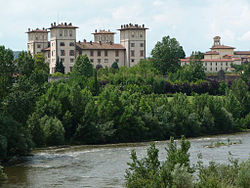The Villa L'Ambrogiana was a rural palace or villa built during the late-Renaissance by Ferdinand I de' Medici; it is located at the confluence of the rivers Pesa and Arno, in the municipality of Montelupo Fiorentino.


History
[edit]Originally, the site was occupied by a casino owned by the Ardinghetti, who sold it to the Corboli, and then to the Medici. Construction of the present palace took place circa 1587, putatively using designs of Bernardo Buontalenti, and built over a pre-existing structure.[1] In the 19th century, Leopold II converted the villa into a mental asylum. In 1886, it was converted into a jail for women and minors, and later into a jail for those judged mentally ill. The Villa and grounds in the 17th century were used by Francesco Redi for anatomic studies of leprosy, and by Andrea Scacciati and Bartolomeo Bimbi to create paintings of flora and fauna for the Grand-Duke Cosimo III de' Medici.
Still in use as an institution for psychiatric illness, guided visits to parts of the building can be requested. The last patient leaves the Montelupo Fiorentino facility in the first ten days of February 2017,
In the following months the complex returns from the Ministry of Grace and Justice in availability of the State Property Agency.
In 2017, a public tender was published to study a guide plan for the complex, project edited by the winners of the tender, Coopculture and P&M Architecture. .[2]
See also
[edit]References
[edit]- ^ Nuova guida della citta di Firenze e d'altre citta' principali della Toscana, Presso Gaspero Ricci (1835) page 523.
- ^ Itinerari Scientifici in Toscana Archived March 11, 2014, at the Wayback Machine entry on the villa].
43°43′51″N 11°00′52″E / 43.73083°N 11.01444°E


Well, that’s interesting to know that Psilotum nudum are known as whisk ferns. Psilotum nudum is the commoner species of the two. While the P. flaccidum is a rare species and is found in the tropical islands. Both the species are usually epiphytic in habit and grow upon tree ferns. These species may also be terrestrial and grow in humus or in the crevices of the rocks.
View the detailed Guide of Psilotum nudum: Detailed Study Of Psilotum Nudum (Whisk Fern), Classification, Anatomy, Reproduction